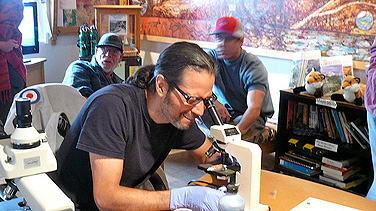News
UB represented at groundbreaking symposium of art and technology

Paul Vanouse looks for Thermus acquaticus bacteria from a nearby hot springs.
UB was well-represented at a prestigious international festival of art and technology held last month in New Mexico.
Seventeen faculty members, PhD students and alumni from the departments of Visual Studies, Media Study and Architecture took part in the ISEA-International Symposia on Electronic Art, held Sept. 19-24 in Albuquerque, Santa Fe and Taos.
The festival, which will take place next year in Sydney, Australia, and in Dubai in 2014, “is one of the most important academic gatherings on electronic art worldwide, bringing together the worlds of art and science,” explains Stephanie Rothenberg, associate professor of visual studies and a featured artist and co-organizer of ISEA 2012.
Rothenberg notes that ISEA, founded in 1990 in the Netherlands, was one of the earliest international networks of organizations and individuals active in the field of the electronic arts. “It has showcased groundbreaking new work from many well-known artists working at the juncture of art and technology,” she says.
Rothenberg attended her first ISEA symposium in 2004, “and was incredibly impressed with the caliber of exhibitions, performances and dialogue.”
“The festival proceedings started in Helsinki and then continued on a small cruise that took participants through the Baltic Sea, stopping in Tallin (Estonia) for more symposium events and exhibitions,” she remembers. “The ship was outfitted with the latest communication technologies, so new media artists could exhibit their work and perform aboard the ship.”
Rothenberg says that besides this year’s ISEA symposium in New Mexico and the 2004 meeting in Helsinki, she’s also attended ISEA symposia in Belfast in 2009 and in Istanbul last year.
“As a traveling festival, it is always different every year, reflecting the culture of each host city and making it a truly unique event,” she says.
The overall theme for this year’s festival was “Machine Wilderness,” aimed at exploring “visions of a more humane interaction between technology and wilderness in which ‘machines’ can take many forms to support life on Earth.”
The event further was comprised of subthemes, she says, that provided frameworks for panels, artwork, workshops and performances. These subthemes were “Radical Cosmologies,” “Trans Species,” “Dynamobilities” and “Econotopias.”
Rothenberg notes that she organized the “Econotopias” subtheme that focused on “creative economies as drivers of possibility. Presentations and artworks in this subtheme explored alternative economic models, such as micro-finance, cooperative living and virtual peer-2-peer currencies,” she says.
The symposium’s keynote speakers were acclaimed artists and scientists working in the field, among them Jaromil, an Italian artist and co-developer of the virtual currency Bitcoin (bitcoin.org); Caroline Woolard, co-founder of Ourgoods.org, an online barter site for cultural production; Ted Howard, co-founder of the Evergreen Cooperatives in Cleveland; Fritz Haeg, an international artist known for his project “Edible Estates;” and noted performance artist Laurie Anderson.
Rothenberg says the UB faculty, students and alumni who attended the symposium debuted new artwork, participated in artist residencies, led panels, presented papers and gave workshops.
For instance, a residency project by Paul Vanouse, professor of visual studies, and Joan Linder, associate professor of visual studies, titled “The People’s PCR,” aims to democratize high-end, genetic-engineering tools. Vanouse describes PCR (polymerase chain reaction) as an algorithmic process in which a small region of DNA is copied billions of times, “amplifying the region, potentially to differentiate individuals.”
In an earlier project, “Deep Woods PRC,” Vanouse devised a way to perform one of the key processes in PCR over a campfire with simple equipment. In “The People’s PCR,” he performed the process on Thermus acquaticus bacteria found in nearby hot springs.
Linder is working on a companion book of drawings documenting the residency process.
Another faculty member, Teri Rueb, professor of media study, exhibited “No Places with Names: A Critical Acoustic Archaeology.” This GPS-based sound walk and sculpture installation drew visitors outside the campus of the Institute for American Indian Art in Santa Fe to explore the concept of wilderness and its shifting meanings across cultural contexts.
Other faculty members participating in IEAS 2012 were Josephine Anstey and Marc Bölen, both associate professors of media study; and Jordan Geiger, assistant professor of architecture.
Students participating were Paul Sargent, a PhD student in media study, and MFA students Laura Curry and Jordan Dalton.
Alumni taking part were Alice Alexandrescu, Tim Scaffidi, Marc Tomko and Caitlin Cass from Visual Studies; Media Study alumni were Anna Schime, Liz Flyntz and Cayden Mak.


Reader Comments